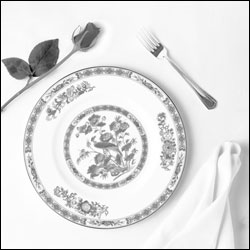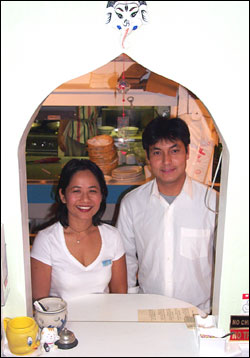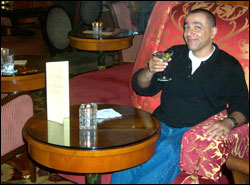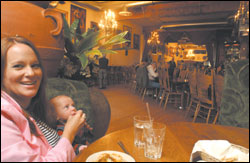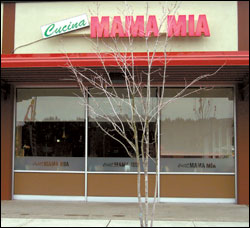The mere mention of the word “chat” makes the average South Asian pine for home and village. In India, “chat” is not homely conversation; it’s a variety of Indian street snack. In North America, chat’s reliance on hot spices (we mean very hot spices) makes the real thing pretty much unmarketable. Apart from Vik’s Chat Corner on Allston Way in Berkeley, Calif. (where a sizable South Asian student population makes chat culture possible), there have been no “chat houses” or “chat bars” hereabouts. Recently we heard about a place called Island Chat House, on Bainbridge Island of all places. One sunny morning soon after, we made a beeline for the ferry and the Island Chat House. Hastening into the charming storefront near the terminal, we took our seats and asked for chat.
Our host, Ranjit Mulgaonkar, a wiry, intense man in his mid-30s who seemed to have dropped out of one of R.K. Narayan’s satirical novels of South Indian village life, told us there was no chat. We pointed out that his restaurant is called the Chat House. “It’s just a name,” he replied, unfazed. “Well, what kind of food do you serve, then?” “We serve Goan cuisine,” was his answer. Well, all right: Goa, a former Portuguese trading post on the Arabian Sea south of Bombay (or should we say Mumbai?), has its distinctive cuisine, so we asked for some: pork vindaloo. Sorry, not today, said Mr. Mulgaonkar. How about chourisso (Goan pork sausage)? A puzzled look. Curried pig’s liver and beer, then. Mr. Mulgaonkar said he didn’t serve pork liver and he didn’t have a beer license.
“So do you have any Goan dishes?” we asked, nearing exasperation. Oh, yes, he said, and pointed to a stainless steel receptacle brimming with viscous minced-lamb kheema, a Muslim dish from North India. “That’s Goan?” we said? Our host nodded blandly and encouraged us to try it.
So we did. And you know, it was actually pretty good, and, at $9.95, reasonably priced. The spicy swordfish curry ($9.95) served with nan, rice, and a side of corn (!!!) was even better. Though we left well fed, it was with broken hearts; the Island Chat House wasn’t what it claimed to be.
BUT LET’S BE FAIR to Mr. Mulgaonkar, who, he told us, had “served as CEO of many a computer technology company” and, we assume, knows the value of a catchy label. Island Chat House is not the first place to hang out a misleading shingle. In fact, it all started with chop suey. Some Chinese chef exiled to California chopped up leftoversbits of meat, water chestnuts, bean sprouts, etc.saut饤 them, and dumped them over rice. VoilࡠFusion was born. A grisly cavalcade has followed. To such fusions of convenience we owe the California roll, Chicago deep-dish pizza, the Indian samosa or pappadum servedick!as an appetizer (at home, they’re tea-time pick-me-ups), and huge plates of “tapas” served as a main course. And let’s not forget the New York bagel dog.
Sometimes the problem’s not convenience but timidity. Why do Thai restaurants insist on serving (Japanese) miso soup? “Because our customers expect it,” say the owners. But they wouldn’t expect it if you didn’t serve it in the first place, would they? Anyway, that doesn’t explain why the same restaurants serve practically no rice, when rice is the center of a sit-down Thai meal. Or why Western diners, eyes streaming, are forced to down their superspicy tom yam soups straight, because no one ever told them that tom yam should be poured over rice to cut the heat. That’s not just inauthentic; it’s mean.
A FEW WEEKS before our chat debacle, we dined at Shamiana, the excellent Zagat-praised restaurant in Kirkland run by Tracy and Eric Larson, who grew up in what they refer to as “East Pakistan” (now Bangladesh), and who could teach Mr. Mulgaonkar a thing or two about creative nomenclature. Take their scallops Shah Jehan ($15.95), succulent and swimming in rich tomato sauce; Shah Jehan, builder of the Taj Mahal, would not have known how a scallop looked, let alone tasted: His capital was inland, and seafood was not on the Mughal menu. The Shah Jehan part was the figment of a chef’s or PR person’s imagination. Likewise, Bangladeshi hero and guerrilla leader Sheikh Mujibur Rahman (aka the Tiger of Bengal) would have looked askance at Shamiana’s tangy, flavorful tamarind pork kebob ($16.95): Tamarind’s a common ingredient in overwhelmingly Muslim “East Pakistan,” but pork? Come now.
But I can’t get too worked up about these little mendacities. In Hindi and Urdu, Shamiana means tent, typically a big patchwork tent of many colors, with room enough for all. Mr. Mulgaonkar needs a good, inclusive name like that. We suggest Chop Curry. Or he could just add some chat to his Island Chat House menu. That way he wouldn’t even have to change his sign.
